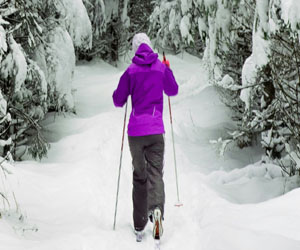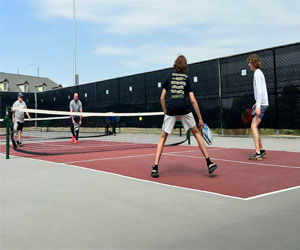


Embracing The Wonders Of Winter

Winter holds a magical allure for adventure seekers. The transformation of the landscape into a glistening wonderland of snow-covered mountains and frozen landscapes beckons those with a love for the great outdoors. Unbridled adventure in the snow provides an exhilarating escape from the daily grind, inviting enthusiasts to explore the pristine beauty and thrills of the winter wonderland.
1. Embracing The White Wilderness: The snow-covered world offers a canvas for outdoor enthusiasts to embrace unbridled adventure. From the soaring peaks of the mountains to the vast expanses of frozen lakes, nature's wintry embrace opens up a realm of possibilities for exploration and discovery.
2. The Art Of Snow Sports: Snow sports are at the heart of unbridled adventure in the snow. Skiing and snowboarding are classic favorites, providing the sensation of gliding down pristine slopes surrounded by snow-capped peaks. The mountain resorts become a playground for novices and seasoned enthusiasts alike, where the thrill of mastering the slopes is both a challenge and a delight.
3. Snowshoeing And Cross-Country Skiing: For those seeking a slower-paced adventure, snowshoeing and cross-country skiing offer an opportunity to venture deep into the winter wilderness. These activities allow exploration of snow-covered forests, tranquil meadows, and hidden alpine lakes, providing a connection with nature that's hard to match.
4. The Call Of The Wilderness: Unbridled adventure in the snow also beckons those who crave a more rugged experience. Backcountry skiing and snowboarding allow for off-piste exploration, where untouched, deep powder snow awaits the intrepid explorer. These pursuits require knowledge of avalanche safety and the ability to navigate through remote, unpatrolled terrain.
5. Ice Climbing: For the ultimate winter adventure, ice climbing takes courage and skill to the next level. Climbers ascend frozen waterfalls and ice-covered rock faces, pushing their limits and embracing the wild beauty of ice formations.
6. Dog Sledding: In the far reaches of the snowy wilderness, dog sledding offers a unique and authentic adventure. Guiding a team of enthusiastic sled dogs through the snowy landscapes evokes a sense of discovery and a connection with the roots of winter exploration.
7. Snowmobiling: Snowmobiling provides an adrenaline-packed way to explore vast snowy expanses. These machines offer the freedom to cover great distances in the snow, from groomed trails to remote backcountry areas.
8. Winter Camping: For the truly adventurous, camping in the snow offers a serene and transformative experience. The stillness of a winter's night, illuminated by the soft glow of the moon on fresh snow, is a memory that will last a lifetime.
9. Embracing Challenges And Thrills: Unbridled adventure in the snow often comes with its own set of challenges, such as extreme weather conditions and rugged terrain. These challenges, however, are what make the experience so rewarding. The thrill of conquering the elements and pushing personal boundaries is an unforgettable part of the journey.
10. Memories To Last A Lifetime: Whether it's the mesmerizing beauty of a snow-covered landscape, the exhilaration of conquering challenging slopes, or the serenity of a winter camping experience, unbridled adventure in the snow creates memories that last a lifetime. These experiences serve as a reminder of the wonders of winter and the indomitable spirit of the adventurous soul.
Unbridled adventure in the snow is an invitation to experience the natural world at its most captivating and challenging. It's a chance to break free from the routine, to explore pristine landscapes, and to embrace the thrill of winter in its most unfiltered form. For those who dare to embark on this journey, the rewards are not just the memories but also the undeniable connection with the wild and the untamed beauty of the snowy world.
Top Injury Prevention Tips
 3. Listen To Your Body: Paying close attention to your body is essential. If you experience pain, discomfort, or unusual sensations during a workout, stop immediately. Ignoring these warning signs can lead to injuries. It's okay to push yourself, but not at the expense of your health.
3. Listen To Your Body: Paying close attention to your body is essential. If you experience pain, discomfort, or unusual sensations during a workout, stop immediately. Ignoring these warning signs can lead to injuries. It's okay to push yourself, but not at the expense of your health.
4. Choose The Right Footwear: Invest in appropriate athletic shoes designed for your chosen activity. Ill-fitting or worn-out shoes can lead to discomfort, instability, and injury. Consult a specialist to find the right pair for your needs.
5. Cross-Training: Variety in your workouts is a key injury prevention strategy. Cross-training involves engaging in a mix of activities, which helps avoid overuse injuries. For example, if you're a runner, consider adding swimming or cycling to your routine.
The Foundation Of Every Great Ride
 Surfboards come in various shapes, sizes, and designs, each tailored to specific wave conditions, rider skill levels, and surfing styles. The key elements of surfboard basics include:
Surfboards come in various shapes, sizes, and designs, each tailored to specific wave conditions, rider skill levels, and surfing styles. The key elements of surfboard basics include:
Length: Longer boards are more stable and buoyant, making them suitable for beginners. Shorter boards are more maneuverable and designed for advanced riders.
Width: Wider boards provide better stability, while narrower boards are more responsive and agile.
Thickness: Thicker boards offer more buoyancy, allowing for easier paddling and wave-catching.
Tail Shape: Different tail shapes affect control and turning abilities. Common tail shapes include round, square, squash, and pin tails.
Rocker: The curve from nose to tail influences a board's maneuverability. More rocker enhances turning ability.






The Perfect Match
 Social Aspect: One of the highlights of pickleball is the camaraderie it fosters. It's a sport where players frequently engage in light banter and laughter during play. The unique scoring system allows for rotation, ensuring that players regularly switch partners and opponents. This social interaction adds to the fun of the game and makes it a great way to meet new people.
Social Aspect: One of the highlights of pickleball is the camaraderie it fosters. It's a sport where players frequently engage in light banter and laughter during play. The unique scoring system allows for rotation, ensuring that players regularly switch partners and opponents. This social interaction adds to the fun of the game and makes it a great way to meet new people.
Competitive Spirit: While pickleball can be a social and recreational pastime, it also offers a competitive edge that drives players to improve. Tournaments and rankings exist at various levels, motivating dedicated players to strive for excellence. The thrill of competition provides an exciting dimension to the sport.
Varied Skill Levels: Pickleball caters to players of varying skill levels. When recreational and competitive players come together on the court, it creates an opportunity for less experienced individuals to learn from their more seasoned counterparts. This mix of skill levels can lead to engaging and educational matches for all involved.
Flexibility: Players can easily adjust the intensity of a pickleball game to suit their preferences. In casual games, the emphasis is on fun, allowing for creative shots and playful rallies. As the stakes rise in competitive play, the focus shifts to precision and strategy. This adaptability makes pickleball suitable for a wide range of players.
A Journey Of Innovation And Growth
 The Frisbee's origins can be traced back to the 1950s, when American inventor Fred Morrison and Warren Franscioni developed the first plastic flying disc. Initially, it was just a toy, popular for tossing around in backyards and parks. However, the transformation from a casual plaything to a sport began in the 1960s, driven by a group of students at Columbia High School in Maplewood, New Jersey.
The Frisbee's origins can be traced back to the 1950s, when American inventor Fred Morrison and Warren Franscioni developed the first plastic flying disc. Initially, it was just a toy, popular for tossing around in backyards and parks. However, the transformation from a casual plaything to a sport began in the 1960s, driven by a group of students at Columbia High School in Maplewood, New Jersey.
In 1968, these students, led by Joel Silver, introduced a new game that involved using a Frisbee to score goals. They called it "Ultimate Frisbee," laying the foundation for what would become one of the most iconic and widely recognized flying disc sports. Ultimate Frisbee's self-officiation, competitive structure, and strong emphasis on sportsmanship set it apart from casual Frisbee tossing and contributed to its growth as a legitimate sport.
The formation of governing bodies played a crucial role in the transformation of Frisbee into a sport. In 1979, the Ultimate Players Association (now USA Ultimate) was established to provide structure and consistency to the growing Ultimate community. Standardized rules and competitive leagues began to emerge, setting the stage for the development of a sport with a global presence.
Ultimate Frisbee's transformation was not limited to the United States. The sport spread internationally, with various countries adopting the game and forming their own national associations.
Recovery Techniques For Sports Injuries
 1. Rest And Immobilization: In the immediate aftermath of an injury, one of the first recovery steps is often rest and immobilization. Rest allows the body to begin the natural healing process, and immobilization can help prevent further damage. This may involve the use of braces, slings, or casts.
1. Rest And Immobilization: In the immediate aftermath of an injury, one of the first recovery steps is often rest and immobilization. Rest allows the body to begin the natural healing process, and immobilization can help prevent further damage. This may involve the use of braces, slings, or casts.
2. RICE Protocol: The RICE protocol is a well-known method for managing sports injuries. It stands for Rest, Ice, Compression, and Elevation. Rest and elevation help reduce swelling, while ice and compression can alleviate pain and inflammation.
3. Physical Therapy: Physical therapy is a cornerstone of sports injury recovery. Skilled physical therapists develop customized exercise programs to help athletes regain strength, mobility, and function. These programs often include stretching, strengthening, and functional exercises.
4. Heat And Cold Therapy: Heat therapy can be beneficial for relaxing tight muscles, increasing blood flow, and easing pain. Cold therapy, on the other hand, can help reduce inflammation and numb pain. The choice between the two depends on the type and stage of the injury.
Embrace The Great Outdoors
 Education And Preparation: One of the most important aspects of wilderness adventure for beginners is proper education and preparation. Familiarize yourself with the specific requirements of your chosen activity, from the gear needed to the environmental conditions you'll encounter. There are numerous online resources, books, and local outdoor organizations that offer workshops and courses to help beginners get started.
Education And Preparation: One of the most important aspects of wilderness adventure for beginners is proper education and preparation. Familiarize yourself with the specific requirements of your chosen activity, from the gear needed to the environmental conditions you'll encounter. There are numerous online resources, books, and local outdoor organizations that offer workshops and courses to help beginners get started.
Gear And Equipment: Investing in the right gear and equipment is a pivotal step for a successful wilderness adventure. Ensure you have the essential items like suitable clothing, comfortable footwear, and a backpack. Make a checklist and double-check that you have everything you need. Rental options are available if you're not ready to invest in gear right away.
Safety First: Safety should always be a top priority. Research the potential risks associated with your chosen adventure, and learn how to mitigate them. For example, if you're hiking in the wilderness, it's crucial to understand navigation, wildlife safety, and first aid. Carry a first-aid kit and let someone know about your plans, including your estimated return time.
Start Small: It's perfectly fine to start with shorter and less challenging trips. Many wilderness areas have well-marked and maintained trails suitable for beginners. Gradually work your way up to more strenuous and remote adventures as your skills and confidence grow.
Leave No Trace: An essential principle for beginners in the wilderness is Leave No Trace. This ethic involves taking care of nature by minimizing your impact. Always pack out what you pack in, dispose of waste responsibly, and respect wildlife and their habitats.
Learn From Experience: Experience is the best teacher when it comes to wilderness adventure for beginners. Embrace each trip as an opportunity to learn and improve. Reflect on your experiences and adapt your skills and knowledge accordingly.